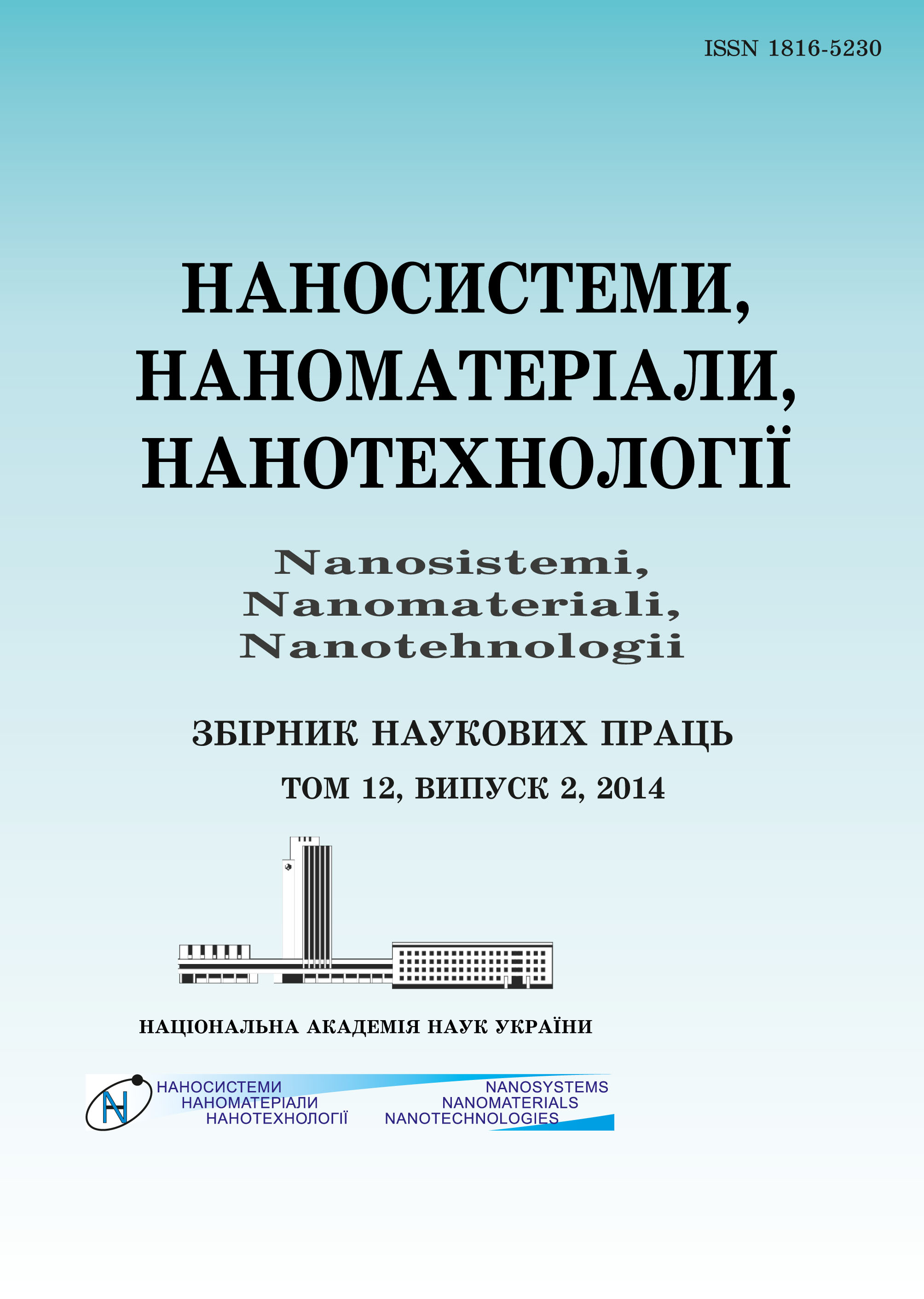|
|
|||||||||
 |
Year 2017, Volume 15, Issue 1 |
|
|||||||
|
|||||||||
Âûïóñêè/2017/òîì 15 /âûïóñê 1 |
L. G. Babich, S. G. Shlykov, A. M. Kushnarova, O. A. Esypenko, and S. O. Kosterin
«Ñalix[4]arene Chalcone Amides—The Nanosize Modulators of Polarization of Mitochondrial Membranes and Content of the Ionized Ca in Them»
193–202 (2017)
PACS numbers: 82.39.Jn, 82.39.Wj, 82.45.Tv, 87.16.D-, 87.16.Tb, 87.50.cj, 87.85.Rs
Mitochondria are known to be ‘power plants’ of cells, and thus, affect the biology of cells in general. A key factor in the mitochondria functioning is the polarization of the inner membrane. So, the search of effectors, which are able to modify the level of polarization of the inner mitochondrial membrane and the concentration of ionized Ca in the matrix of these organelles, is important from both theoretical and practical points of view. Ñalix[4]arenes, due to their ability to form complexes with biologically important molecules and ions, can influence the course of various biochemical processes. As shown, the calix[4]arene chalcone amides C-136 and C-137 increase the polarization of myometrial mitochondria membranes and ionized-Ca concentration in the matrix of these organelles. The degree of calix[4]arene chalcone amides’ influence on the ionized-Ca concentration within the matrix of mitochondria depends on Ñà2+-accumulating activity of the mitochondria, namely, if the mitochondria accumulate Ca2? more actively, there is the greater calix[4]arene chalcone amides’ impact. As suggested, the calix[4]arene chalcone amides C-136 and C-137 might be useful when mitochondria membrane potential and ionized-Ca concentration corrections are required.
Key words: calix[4]arene, polarization of mitochondria membranes, ionizedCa concentration within the mitochondria matrix.
https://doi.org/10.15407/nnn.15.01.0193
REFERENCES
1. B. Orlikova, D. Tasdemir, F. Golais, M. Dicato, and M. Diederich, Genes Nutr., 6, No. 2: 125 (2011). https://doi.org/10.1007/s12263-011-0210-5
2. D. K. Mahapatra and S. K.Bharti, Life Sci., 148: No. 154:72 (2016). https://doi.org/10.1016/j.lfs.2016.02.048
3. B. Zhou and C. Xing, Med. Chem. (Los Angeles), 5, No. 8: 388 (2015).
4. A. J. Leon-Gonzalez, N. Acero, D. Munoz-Mingarro, I. Navarro, and C. Martin-Cordero, Curr. Med. Chem., 22, No. 30: 3407 (2015). https://doi.org/10.2174/0929867322666150729114829
5. S. Zhang, T. Li, Y. Zhang, H. Xu, Y. Li, X. Zi, H. Yu, J. Li, C-Y. Jin, and H.-M. Liu, Toxicol Appl. Pharmacol., 30977: 86 (2016).
6. M. A. Klyachina, V. I. Boyko, A. V. Yakovenko, L. G. Babich, S. G. Shlykov, S. O. Kosterin, V. P. Khilya, and V. I. Kalchenko, J. Incl. Phenom. Macrocycl. Chem., 60, Nos. 1-2: 131 (2008). https://doi.org/10.1007/s10847-007-9361-9
7. F. Arnaud-Neu, E. M. Collins, M. Deasy, G. Ferguson, S. J. Harris, B. Kaitner, A. J. Lough, M. A. McKervey, and E. Marques, J. Am. Chem. Soc., 111, No. 23: 8681 (1989). https://doi.org/10.1021/ja00205a018
8. P. Mollard, J. Mironneau, T. Amedee, and C. Mironneau, Am. J. Physiol., 250, No. 1, Pt. 1: C47 (1986). https://doi.org/10.1152/ajpcell.1986.250.1.C47
9. S. A. Kosterin, N. F. Bratkova, and M. D. Kurskii, Biokhimiya, 50, No. 8: 1350 (1985) (in Russian).
10. M. M. Bradford, Anal Biochem., 72: 248 (1976). https://doi.org/10.1006/abio.1976.9999
11. G. Grynkiewicz, M. Poenie, and R. Y. Tsien, J. Biol. Chem., 260, No. 6: 3440 (1985).
12. Y. N. Antonenko, A. V. Avetisyan, D. A. Cherepanov, D. A. Knorre, G. A. Korshunova, O. V. Markova, S. M. Ojovan, I. V. Perevoshchikova, A. V. Pustovidko, T. I. Rokitskaya, I. I. Severina, R. A. Simonyan, E. A. Smirnova, A. A. Sobko, N. V. Sumbatyan, F. F. Severin, and V. P. Skulachev, J. Biol. Chem., 286, No. 20: 17831 (2011). https://doi.org/10.1074/jbc.M110.212837
13. A. S. Divakaruni and M. D. Brand, Physiology (Bethesda), 26, No. 3: 192 (2011). https://doi.org/10.1152/physiol.00046.2010
14. M. L. Olson, S. Chalmers, and J. G. McCarron, Biochem. Soc. Trans., 40, No. 1: 158 (2012). https://doi.org/10.1042/BST20110705
15. G. Di Benedetto, D. Pendin, E. Greotti, P. Pizzo, and T. Pozzan, J. Physiol., 592: 305 (2014). https://doi.org/10.1113/jphysiol.2013.259135
16. L. G. Babich, S. G. Shlykov, L. A. Borisova, and S. A. Kosterin, Biokhimiya, 59, No. 8: 1218 (1994).
17. L. G. Babich, S. G. Shlykov, A. M. Kushnarova, and S. O. Kosterin, Ukr. Biochem. J., 88, No. 4: 5 (2016).
18. R. Rodik, V. Boiko, O. Danylyuk, K. Suwinska, I. Tsymbal, N. Slinchenko, L. Babich, S. Shlykov, S. Kosterin, J. Lipkowski, and V. Kalchenko, Tetrahedron Lett., 46, No. 43: 7459 (2005). https://doi.org/10.1016/j.tetlet.2005.07.069
19. S. B. Nimse and T. Kim, Chem. Soc. Rev., 42, No. 1: 366 (2013). https://doi.org/10.1039/C2CS35233H
20. V. V. Trush, S. G. Kharchenko, V. Y. Tanchuk, V. I. Kalchenko, and A. I. Vovk, Org. Biomol. Chem., 13, No. 33: 8803 (2015). https://doi.org/10.1039/C5OB01247C
21. S. G. Shlykov, L. G. Babich, N. M. Slichenko, R. V. Rodik, V. I. Boyko, V. I. Kal'chenko, and S. O. Kosterin, Ukrains'kyi Biokhimichnyi Zhurnal, 79, No. 4: 28 (1999) (in Ukrainian).
|
©2003—2021 NANOSISTEMI, NANOMATERIALI, NANOTEHNOLOGII G. V. Kurdyumov Institute for Metal Physics of the National Academy of Sciences of Ukraine.
E-mail: tatar@imp.kiev.ua Phones and address of the editorial office About the collection User agreement |